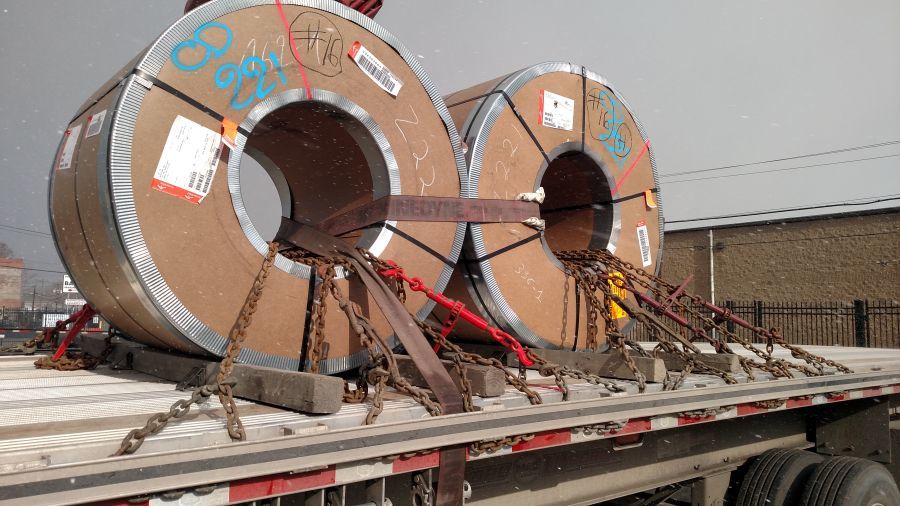Taking A Look At Securing A Flat-Bed Load
Topic 3287 | Page 6

Believe it or not, there are some loads where you can not get your securement inside the rub rails. Depending on how it is loaded, for instance, staggered man holes will come out right to the rub rail and now you have to secure it but the manhole is sitting on the rail. When you have 10 manholes going on the trailer you don't have the option of crossing chains so you go under and hook to the frame on the edge of the bed. The bell end of a large pipe can be difficult too as they are 102" long.
Then you have oversized and you do not want to be pulling out on your rub rails.
When I remember, I will have to get some photos. Usually trying to get moving so I can get back that night or the next morning for another load.
I am so thankful I don't have to deal with all of this headache! Go Reefer!
Reefer:
A refrigerated trailer.
DAC:
Drive-A-Check Report
A truck drivers DAC report will contain detailed information about their job history of the last 10 years as a CDL driver (as required by the DOT).
It may also contain your criminal history, drug test results, DOT infractions and accident history. The program is strictly voluntary from a company standpoint, but most of the medium-to-large carriers will participate.
Most trucking companies use DAC reports as part of their hiring and background check process. It is extremely important that drivers verify that the information contained in it is correct, and have it fixed if it's not.

Brett, I guess my description wasn't very clear.  The strap is routed inside the rub rail with the hook hung on the outside of the rub rail. Gravity holds the hook in place as you tighten the strap. When pulled tight, pretty much only the metal hook is exposed. If that is sheared off there would probably be some other issues with the load, trailer and tractor. Chains are always inside the rub rail since they are wrapped around a spool or pocket. When I get a chance, I will post a picture of it. I know that Melton's safety department are excellent and work with the DOT if there are questions or issues.
The strap is routed inside the rub rail with the hook hung on the outside of the rub rail. Gravity holds the hook in place as you tighten the strap. When pulled tight, pretty much only the metal hook is exposed. If that is sheared off there would probably be some other issues with the load, trailer and tractor. Chains are always inside the rub rail since they are wrapped around a spool or pocket. When I get a chance, I will post a picture of it. I know that Melton's safety department are excellent and work with the DOT if there are questions or issues.
Daniel B. - I don't think I could do anything else at this point. I like the challenges of each load being a bit different and learning tricks and tips that other drivers share. Some times I just nod and smile, other times I incorporate. Never been involved in physical labor as an adult, so this is a nice change of pace and I never have to worry about staying in shape or my weight. That has a tendency to happen as we get more "mature". Trust me, your time will come. 
DOT:
Department Of Transportation
A department of the federal executive branch responsible for the national highways and for railroad and airline safety. It also manages Amtrak, the national railroad system, and the Coast Guard.
State and Federal DOT Officers are responsible for commercial vehicle enforcement. "The truck police" you could call them.
Hey all, I've been way to busy to jump in here lately, but thankfully I can do it today.
Little Joe, I think when it comes to the rub rail I would call it "best practices" to make sure everything is inside the rub-rail. Just like Pat pointed out there are times when it just can't be avoided. We have certain trailers in our fleet that have no place to hook the hook unless you use the rub rail, and on those trailers I will always alternate which way each strap is pulling so that every other strap is inside the rail going down either side of the trailer, of course this is a good practice anyways as Larry E. stated. I pointed it out because it is a tip that even some folks that have been flat-bedding for a while don't seem to practice. I've determined that if the D.O.T. is going to ding you for something on your securement practices they are going to figure out a way to get you. We do the absolute best we can at following their guidelines, but some of them are not as clearly defined as they could be. Fortunately, I've yet to be ticketed on any infraction, although the Port Authority at the George Washington Bridge had three D.O.T. inspectors climbing all over an over-sized load I had just trying their best to come up with a reason to cite me, but alas even after getting out their measuring tapes to make sure I didn't have too much space in between my straps they eventually gave up and went back to their frustrated supervisor, who I had already accidentally irritated, with no infractions found.
Hey Larry, good to hear from you, I was hoping to get you in on this discussion, thanks for joining us.
WineTaster, you've asked a brilliant question, one I was expecting some one to ask earlier, but alas, a brand new rookie asked the question that I thought would be most obvious - I think we flat-bedders who haven't been in training for a while forget some of the things we really should know. Congratulations, You are the winner of the "Steak Dinner" prize! Now all you've got to do is catch up with me, and you can ask Daniel - that is hard to do. Daniel keeps meeting all kinds of folks from Trucking Truth, but he keeps making these goals of finding me and getting a steak dinner from me, but his little pink truck just can't keep up the pace! You are exactly right in what you say about reducing the WLL by half when anchoring to the freight and returning back to the same side of the trailer. Here is why I didn't calculate it that way: Those transformers were a little over six feet wide and a little over eight feet long. Because of their size and the configuration of the chain going "through" the loops provided on the base of the transformers, it was the same physics as going over the freight and to the other side of the trailer, even though I was returning to the same side. This is a situation where I may have gotten a hard-nosed officer into a debate about the way things are worded in their guidelines, but I'm going to be honest with you here, if you know your stuff and can prove it by the way you respectfully talk to them you are way ahead of the game. If you act like a dummy that isn't sure why he secured something the way you did, then you're in trouble. The truth is that you probably know more than 98% of the D.O.T. officers out there when it comes to best securement practices - I know this because of the question you asked me about this load. Another reason for the way I secured this load is that I was trying to keep it as simple as possible for the sake of the discussion here. It was an effort to expose some of the new readers of the forum to the joys of flat-bedding.
Like Larry E. pointed out, I don't think I can do another type of freight right now, I thoroughly enjoy the challenges involved in this. I like using my head and my wits to meet the demands of the law when it comes to securing my loads. I enjoy getting physical every day, I like having a new view out my rear-view mirrors. I can't even really explain it, this stuff just kind of gets in your blood, it becomes something you really love doing - it's just sort of a flat-bedder's mentality and code of honor that drives you. If you don't understand that it's fine, your not a flat-bedder, and I certainly don't hold that against anyone, if you do understand it then you are part of a brother-hood that's had a singular bond with each other for generations now. How often have you seen guys pulling a reefer or a dry van stopping and helping out another driver at a receiver or shipper? I remember one time when I was in a receivers location and I was out helping a guy fold his tarps up when a dry van truck pulled in and was confused as to where he was supposed to go to - well he pulled up so that he was parked right in our way, so we went over to his door and he sheepishly rolled down his window like we were about to bite his head off. We were just offering to help him out and show him where to pull his truck to so he could get unloaded. He thanked us profusely and got into the proper position then he climbed out and come over to "watch us" work. He admired our willingness to help each other and told us so as he began telling us that one day he was going to become a "real trucker" and drive a flat-bed.
I have a lot of respect for all truck drivers, so don't any one take offense at that little story, I'm just telling you what happened that day. "Knights of the Highway" - we need em!
Shipper:
The customer who is shipping the freight. This is where the driver will pick up a load and then deliver it to the receiver or consignee.
Dm:
Dispatcher, Fleet Manager, Driver Manager
The primary person a driver communicates with at his/her company. A dispatcher can play many roles, depending on the company's structure. Dispatchers may assign freight, file requests for home time, relay messages between the driver and management, inform customer service of any delays, change appointment times, and report information to the load planners.Dry Van:
A trailer or truck that that requires no special attention, such as refrigeration, that hauls regular palletted, boxed, or floor-loaded freight. The most common type of trailer in trucking.Reefer:
A refrigerated trailer.
HOS:
Hours Of Service
HOS refers to the logbook hours of service regulations.OWI:
Operating While Intoxicated

Thank you, Old School & Guyjax. I will keep this post in my Notebook. When driving Reefer the most importsnt thing is temperature (and Reefer fuel). I will be wrasslin' with flatbed my second time around. New experience. Feeling a bit anxious.
Old school, that was a very informative and well organized post. I can tell you put some time into it. Many thanks.
P.S. Maybe I'll read it later if I have time.
Reefer:
A refrigerated trailer.
Not sure if this is the right spot to post. New to flatbed and wish to ensure all my loads are above and beyond requirements. Here's a recent load <11k per coil.
All constructive criticism welcomed.

What's with the strap between the two coils connecting them?
Did anyone ever get more Clarification on whether the spacer or stake pocket was the most efficient method?
Above and beyond requirements. Does it have a positive or negative effect of securement?
What's with the strap between the two coils connecting them?
New Reply:
New! Check out our help videos for a better understanding of our forum features

















Preview:
This topic has the following tags:
Driver Responsibilities Flatbed High Road Training Program Load Securement Photos Safe Driving Tips Understanding The Laws







 TT On Facebook
TT On Facebook
That is quite an odd answer from your safety guy. So if you get caught up in a wreck and someone scrapes along the side of you, your safety guy doesn't see any sense in worrying about whether or not a strap or chain will break and send a 25,000 pound coil hurling across the highway or through the back of the cab?
My question would be, "What is the advantage to routing anything outside of the rub rail when there are a million ways to safely secure a load without going outside the rub rail?"
It seems like a matter of assessing the risk/reward ratio. What is the reward for securing a load that way versus the obvious catastrophic risk?
DOT:
Department Of Transportation
A department of the federal executive branch responsible for the national highways and for railroad and airline safety. It also manages Amtrak, the national railroad system, and the Coast Guard.
State and Federal DOT Officers are responsible for commercial vehicle enforcement. "The truck police" you could call them.